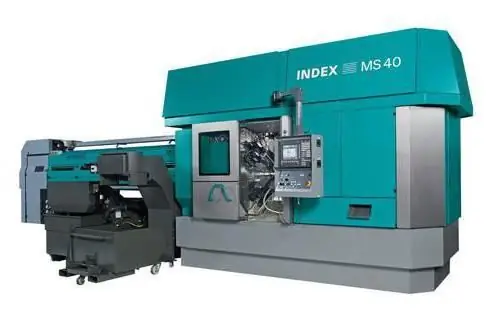2025 Author: Howard Calhoun | [email protected]. Last modified: 2025-01-24 13:10:37
The rapid development of the metalworking industry is hardly imagined without the constant improvement of the machine tools used. After all, the tools used depend on how quickly the parts will be sharpened, the quality of the finished product and compliance with the geometry.
Introduction

Why do I need a lathe chuck? It is used to fix workpieces. It ensures the required clamping force and centering accuracy. Lathe chucks can be installed on both special and universal machines. They fasten the parts along the axis of the spindle. This makes it possible to achieve a secure hold and increase the clamping force in cases where there is a large torque. Thanks to this, the part does not break and continues to maintain the correct position during processing. It also reduces the risk of cutter breakage. All this together allows to provide high speed of production of products. They produce a turning chuck from hardened steel, although they can also be made from cast iron. They differ from each other in design and purpose. In the Russian Federation for themthere are eight standards that describe the requirements for the elements.
About classification

Any lathe chuck can be attributed to one of two groups: it is either collet or cam. The former are produced with a non-retractable or retractable sleeve that secures the part in the required position. The latter are made with several movable segments called cams. Thanks to them, the details are fixed. Cams can be used in a large number of operations. They may differ in purpose and design features. If we talk about classification, then the lathe chuck can be assigned to a certain group depending on one of the indicators:
- Number of cams. Varies from two to six.
- Mounting features. It is located on the inner or outer surface.
- Specific performance. Solid jaws, top jaws, or prefabricated jaws.
- Drive used. Can be mechanical or manual.
All of these have implications for usage and specific functions.
More about chucks

Let's go through the most popular options:
- Self-centering two-jaw chucks. This option is used to fasten complex shaped parts, non-cylindrical and asymmetrical workpieces. Lathe chucks of this type are distinguished by the ability to fix raw surfaces in jaws,while providing adequate grip. This product is made of steel and subjected to heat treatment of moving parts. As a result, strong and wear-resistant cartridges are obtained. Among the disadvantages, mention should be made of the fact that there is a high risk of misalignment. This is due to the wide gap between the guides.
- Three-jaw lathe chuck. The most common option. It can be found in home workshops, industrial plants, assembly shops and garages. Usually accompanied by a traction drive. Its presence reduces the amount of time required for fixation by about 30-80%. This optimization allows you to speed up the process. This is especially important in cases where there is a large load. For example, this is on serial machines. The presence of a mechanized drive allows you to get another important advantage, namely, the constancy of the clamping force. Thanks to this, the part does not fly out and does not warp at any speed.
- Four-jaw turning chucks. They are used when it is necessary to machine non-symmetrical workpieces, provided that the boring holes are in different axes or a round part needs to be ground off-center.
More about collet chucks

The key working element here is the metal sleeve. It can be divided into three, four or six petals. Their number determines the maximum diameter of the fixed products that can be held by turningcartridges. After all, metal plates capture the part that is inserted inside the sleeve. They also hold it throughout the entire workflow. Structurally, collets are divided into supply and clamping. The peculiarity of the latter is the presence of three incomplete cuts on the steel hardened bushing. The first ones use spring type petals.
Recommended:
Automatic lathe and its characteristics. Automatic lathe multi-spindle longitudinal turning with CNC. Manufacturing and processing of parts on automatic lathes

Automatic lathe is a modern equipment used mainly in mass production of parts. There are many varieties of such machines. One of the most popular types are longitudinal turning lathes
Household metal lathe: types, description

Household lathe: overview, specifications, manufacturers, features. Desktop lathe: description, varieties, operation, photo
Drive screw for lathe and vice

The lead screw is one of the main parts used in lathes, table vise, etc. This screw is responsible for the movement of the vise, and therefore there are many parameters that it must comply with
Metalworking lathe

The article is devoted to metalworking lathes. The characteristics of such equipment, types, manufacturers, etc. are considered

